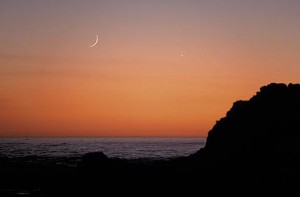Is the Moon’s orbit inclined sufficiently that, when it misses the Sun by the greatest amount north (or south), the lunar crescent could be seen in a telescope at new Moon?

Youssef M. Ismail
Probably not. The inclination of the Moon’s orbit to the ecliptic varies from 5.0° to 5.3°. French astronomer André Danjon (1890–1967) showed that no crescent is visible when the Moon–Sun separation is less than a specific angle — the Danjon limit — believed to be near 7°.
But you’ve put your finger on a key factor in seeing the crescent as soon as possible after new Moon. Another requirement is for the Moon to be near perigee (closest to Earth), when it will make the quickest possible getaway from the Sun’s vicinity. The current record holder is Mohsen Mirsaeed, who used giant binoculars to spot the lunar crescent only 11 hours 40 minutes past new Moon on September 7, 2002, from a mountainous location in Iran (S&T: February 2004, page 105). The Moon’s ecliptic latitude (geocentric) was then +4.9°, and it came to perigee 12 hours later.
— Roger W. Sinnott
 0
0







Comments
You must be logged in to post a comment.